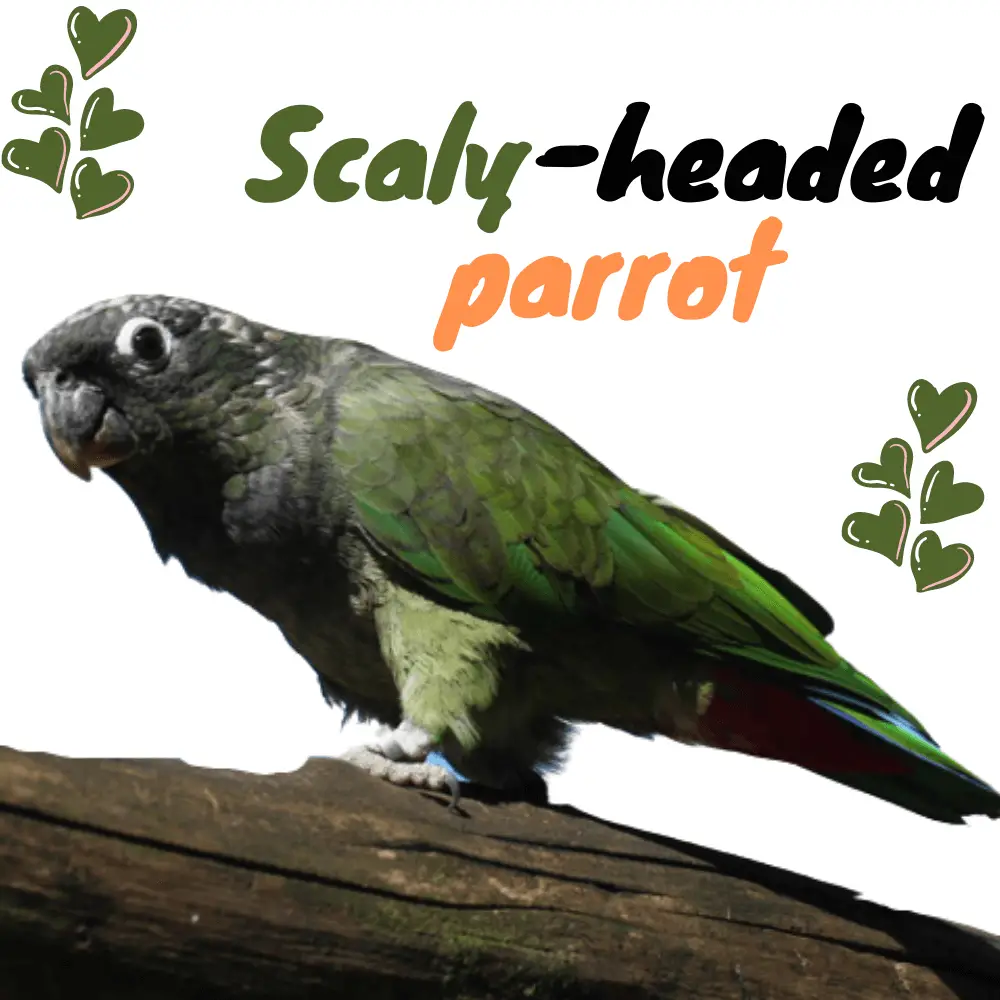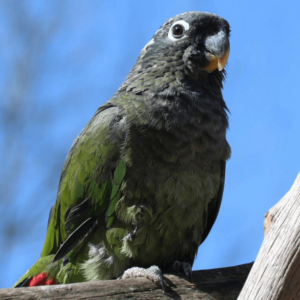
The Scaly-headed parrot has the scientific name of Pionus maximiliani and is a bird in the Psittacidae family. It is also known by the names of tanned maitaca, baitaca, maitaca, maitaca-de-maximiliano, maitaca-suia, umaitá, and maritaca.
In English, it is called the Scaly-headed Parrot. To date, this bird has not been threatened with extinction, however, illegal trade and man-made deforestation have affected its habitat.
When aviculturists refer to these birds, they often refer to them as Maximilian’s Pionus, Scaly-headed Parrots, or Scaly-headed Pionus. All of these names are acceptable, although Maximilian’s Pionus seems to be the most widely used.
The typical Scaly-headed parrot can reach a length of 12 inches from head to tail at maturity, although it is more common for these birds to be between 10 and 11 inches. The normal weight for an adult bird of this species is around 8 to 9 ounces.
OTHER BIRDS IN THIS FAMILY
Scaly-headed parrot Distribution
This bird is found in countries like Argentina, Bolivia, and Paraguay. In Brazil, it is found in the Midwest, Northeast, and South regions of the country.
Green maitaca usually adapt to different locations, being found in savannas, galleries, humid forests, and other habitats. Generally, the maritaca is found in flocks ranging from 6 to 50 birds, depending on the amount of food in the place.
Origin
Scaly-headed parrots are native to the forests and woodlands of South America, specifically an area from Brazil to Argentina. However, due to its popularity in the pet trade in recent years, Maximilian’s Pionus is kept in captivity in homes around the world.
Physical characteristics
As an adult, she measures approximately 23 centimeters and weighs between 230 to 260 grams. This bird has its predominant green plumage, with its bluish-gray head, as well as the bottom of its neck.
Its wings are green and its chest is yellow. Its tail is short and green, the feathers below it are red and its beak is yellow. The area around your eyes is free
Owners of Scaly-headed parrots describe their personalities as fun, comical, affectionate, and a bit mischievous. Granted, these traits can apply to all hookworms, but the charm of Maximilian’s Pionus seems to set them apart even from other Pionus species.
They are known to be the best talkers among the Pionus, building up an impressive vocabulary and practicing tricks well. This could be explained by the fact that the Scaly-headed parrots like to spend a lot of time with their owners.
Anyone interested in adopting one of these birds should make sure they have plenty of time to play, socialize, and interact with their feathered friend. of feathers.

Colors
In terms of colorful plumage, Scaly-headed parrots are often overlooked in favor of brighter feathered parrots. At first glance, these birds may appear shabby or even dull, but a closer look reveals real beauty in their coloring.
The predominant color of these birds is a brownish olive green, but it is highlighted by a golden bronze-like luster on their undersides.
Their heads are covered in darker colored feathers, edged with lighter gray, a feature that has led to them being called “scaly-headed parrots” by some.
The brightest parts of these parrots are, by far, their tails. The tail feathers of Scaly-headed parrots are a rainbow of green, blue and red, adding the perfect finishing touch to these neat-looking birds.
Scaly-headed parrot as pets
Known as one of the quietest bird species, the scaly-headed parrot could be a good choice for those who want a larger parrot but don’t want to deal with the extra screaming and noise that comes with a bird.
like a macaw or a cockatoo. Although easily bored due to their high intelligence, busy Maximilian’s Pionus are known to be gentle and affectionate pets that thrive on the bond they form with their owners.
If you would like to learn more about keeping a scaly-headed parrot, contact a local breeder or a bird club or poultry society in your area.
A scaly-headed parrot needs lots of exercise in order to maintain the best physical condition possible. For the healthiest birds, it is recommended to let them out of their cage at least 3 to 4 hours a day, in a supervised area, and away from birds. This gives them the opportunity to play, stretch and make sure all their muscle groups are getting a good workout.
PIONUS PARROTS as PETS – EVERYTHING You Wanted to KNOW
SOURCE:PippyPets
Scaly-headed parrot feeding
Like other types of parrots, most scaly-headed parrots do well in captivity when fed a high-quality seed and pellet mix, supplemented with fresh fruits and vegetables daily.
Like some other types of birds, Maximilian Pioneers are known to be prone to obesity, so it is recommended to closely monitor their intake of high-fat foods, such as sunflower seeds and nuts.
They also need a higher intake of certain vitamins than other birds, especially vitamin A. To do this, many scaly-headed parrots owners ensure that their diet includes plenty of fresh, leafy green vegetables, such as spinach, romaine lettuce, and kale.
Scaly-headed parrot Lifespan


Like all parrots, Scaly-headed parrots can live quite a long time. In fact, these birds typically live up to 40 years as captive pets, and some can live even longer.
That’s why it’s so important for anyone considering adopting one of these birds to do plenty of research on the species before bringing one home. Caring for an animal for 40 years or more is a long-term commitment that should not be taken lightly.
Reproduction of Scaly-headed parrot
The female of the Scaly-headed parrot usually lays about 4 eggs, white in color, per laying. The couple makes their nest in places away from the flock, such as hollows of trees, ravines, among other places with cracks.
Her nest is made using wood shavings and the female’s own feathers. The incubation period takes between 20 to 25 days.
During the day it is the male who takes care of the puppies. When they reach around 60 days, the chicks leave the nest and start to live on their own.
Scaly-headed parrot sounds
How to download or listen to songs of the Scaly-headed parrot
You can download the Scaly-headed parrot song on our website. To do this, just right-click on the name of the corner, then click on (Save Link As and choose the location where it will be saved). You can also listen, just click on the play button.




















